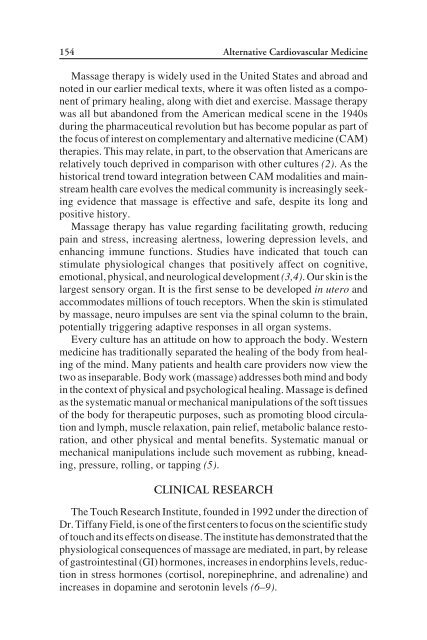Complementary Alternative Cardiovascular Medicine
Complementary Alternative Cardiovascular Medicine
Complementary Alternative Cardiovascular Medicine
You also want an ePaper? Increase the reach of your titles
YUMPU automatically turns print PDFs into web optimized ePapers that Google loves.
154 <strong>Alternative</strong> <strong>Cardiovascular</strong> <strong>Medicine</strong><br />
Massage therapy is widely used in the United States and abroad and<br />
noted in our earlier medical texts, where it was often listed as a component<br />
of primary healing, along with diet and exercise. Massage therapy<br />
was all but abandoned from the American medical scene in the 1940s<br />
during the pharmaceutical revolution but has become popular as part of<br />
the focus of interest on complementary and alternative medicine (CAM)<br />
therapies. This may relate, in part, to the observation that Americans are<br />
relatively touch deprived in comparison with other cultures (2). As the<br />
historical trend toward integration between CAM modalities and mainstream<br />
health care evolves the medical community is increasingly seeking<br />
evidence that massage is effective and safe, despite its long and<br />
positive history.<br />
Massage therapy has value regarding facilitating growth, reducing<br />
pain and stress, increasing alertness, lowering depression levels, and<br />
enhancing immune functions. Studies have indicated that touch can<br />
stimulate physiological changes that positively affect on cognitive,<br />
emotional, physical, and neurological development (3,4). Our skin is the<br />
largest sensory organ. It is the first sense to be developed in utero and<br />
accommodates millions of touch receptors. When the skin is stimulated<br />
by massage, neuro impulses are sent via the spinal column to the brain,<br />
potentially triggering adaptive responses in all organ systems.<br />
Every culture has an attitude on how to approach the body. Western<br />
medicine has traditionally separated the healing of the body from healing<br />
of the mind. Many patients and health care providers now view the<br />
two as inseparable. Body work (massage) addresses both mind and body<br />
in the context of physical and psychological healing. Massage is defined<br />
as the systematic manual or mechanical manipulations of the soft tissues<br />
of the body for therapeutic purposes, such as promoting blood circulation<br />
and lymph, muscle relaxation, pain relief, metabolic balance restoration,<br />
and other physical and mental benefits. Systematic manual or<br />
mechanical manipulations include such movement as rubbing, kneading,<br />
pressure, rolling, or tapping (5).<br />
CLINICAL RESEARCH<br />
The Touch Research Institute, founded in 1992 under the direction of<br />
Dr. Tiffany Field, is one of the first centers to focus on the scientific study<br />
of touch and its effects on disease. The institute has demonstrated that the<br />
physiological consequences of massage are mediated, in part, by release<br />
of gastrointestinal (GI) hormones, increases in endorphins levels, reduction<br />
in stress hormones (cortisol, norepinephrine, and adrenaline) and<br />
increases in dopamine and serotonin levels (6–9).


